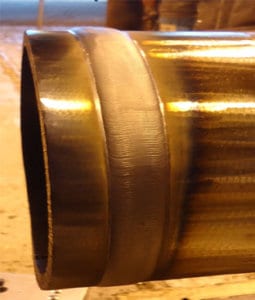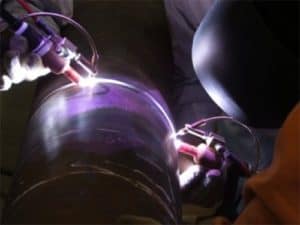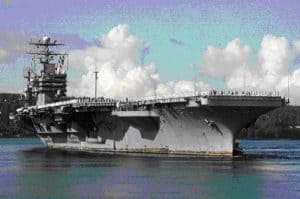Industries & Manufacturing
TIP TIG & Aerospace
TIP TIG Nuclear & Fossil Fuel
TIP TIG Defense
TIP TIG Nuclear - Fossil Power - Refinery & Waste Management
_______________________________________________________________________________________ For at least seven decades, the manual weld processes of choice in all power plants has been DC TIG, SMAW and the Gas Shielded Flux Cored process. When automated PIPE welds were required, the GTA Hot or Cold Wire process was considered. The power industry like other high tech industries can be notorious in their resistance to weld change. It's notable that the working span of the average weld engineer is 30 years and I hope that someone will be aware in 2022, that 13 years have passed since I introduced TIP TIG to N. America and Australia. While most engineers in this important industry are still not aware of TIP TIG, surely someone in the engineering departments, would want to be aware of a weld process that is easier to use than TIG, will provide superior open root and fill pass quality on any pipe joints, vessels or plate welds. And one welder using this process will provide in one hour, the same weld production as three TIG welders _____________________________________________________________________________________ SURELY SOMEONE HAS AN INTEREST IN ATTAINING THE BEST MECHANICAL OR METALLURGICAL PROPERTIES: Any metallurgist or engineer should be aware that TIP TIG is "the only arc weld process that produces both the highest arc weld energy with the lowest welded part heat input". This enables the best possible weld quality and mechanical and corrosion properties with any metals. SURELY MANAGERS WANT TO KEEP IT SIMPLE. Every engineer and manager when possible should hopefully want to promote the KIS method for their all position pipe, plate and vessel welds. TIP TIG reduces all position welder skills. TIP TIG, one weld process for manual and automated welds. TIP TIG one weld process from root to cap. TIP TIG one power source, one wire, one gas, one weld procedure. TIP TIG will never require more than two common weld settings for most of the welds found in a Nuclear plant. And most important this is the only weld process capable of eliminating all position weld rework requirements that is associated with ASME. NAVSE. API and AWS code quality welds.
TIP TIG Oil & Nat Gas
_____________________________________________________________________________________ Pipes, valves, vessels, pumps, tanks and structural applications, manual or automated all position welds, or cladding made on a wide variety of alloys, steels and high strength steels. Welds and part metallurgy are always common concerns. However in this is a classic "why change the way we have always done it industry" in which the sad management and engineering focus is typically placed on revealing weld defects, rather than on the more logical cost effective engineering approach, of ensuring those responsible for the welds, have the weld process controls - best weld practice expertise to prevent weld defects. _____________________________________________________________________________________ With the high cost of many code quality welded parts, and the necessary costly weld rework, lets also not forget, as shown left, that a single weld failure can lead to extensive risks to human life and dollars liability sometimes measured in the billions. So why after TIP TIG has been around for a decade, would any relevant manager or engineer in this industry select inferior arc weld processes such as GTA - Pulsed MIG - SMAW or Gas Shielded Flux Cored for their code weld applications?
TIP TIG & Medical Industry
TIP TIG Food & Beverage
TIP TIG Ship Building & the Navy
Shipyard weld quality is greatly influenced by the weld joints presented by the fitters, (often not to the design dimension and condition requirements). Weld quality is also influenced by the prime weld process selected which is gas shielded flux cored, a process that creates many inherent weld quality issues as discussed in the "process section. And the other prime influence on attaining the best possible and uniform weld quality with FCA, is the lack of flux cored process control - best practice training.
TIP TIG like flux Cored is also a semi-automated weld process and there are many weld applications in ship yards in which this process should be considered. TIP TIG will not replace flux cored, however when utilized in ship yards, TIP TIG will always provide the best possible manual or automated weld quality with the best opportunity for zero weld rework. TIP TIG allows weld VEE prep reductions that will dramatically reduce the amount of weld and weld consumables. Welding in a confined area, TIP TIG produces the lowest weld heat for the welders with no weld spatter and the lowest weld fumes. TIP TIG also dramatically reduces the all position skill requirements. Pipe shops, or welding turbine or nuclear components as found on naval vessels will all benefit from TIP TIG. When possible, if TIP TIG is used on any high strength steels and alloy steels, with the EN polarity and increased weld speeds, TIP TIG will ensure the lowest weld part heat the lowest distortion and stresses along with best possible mechanical or corrosion properties.
So there are two things that will in 2022, allow ship yards to provide progressive process changes that will impact the weld quality and productivity. [1] TIP TIG. [2] Ensure that with flux cored or MIG that all weld decision makers are provided Flux Cored, MIG and also TIP TIG "Weld Process Controls and Best Weld Practice" Training. This is very different from the typical ship yard welder training programs that frequently place their training focus on the welder skills rather than on the process controls.
My weld process control self teach or training resources, available at this site will enable both front office weld process ownership, and weld shop, weld quality and weld productivity optimization. When welders play around with weld controls and the weld equipment, process and consumables utilized are not attaining the maximum potential, and when the best possible weld processes are not utilized this should be a wake up call for front office personnel.

FURTHER COMMENT FROM EM. “WHY WOULD ANY WELD SHOP IN A NAVY YARD OR AT ANY DEFENSE OR AEROSPACE COMPANY SELECT A WELD PROCESS THAT INFLUENCES THE COMMON WELD ISSUES THAT OCCUR WITH MOST ALLOY AND ALLOY STEELS”? For example, if you are a key weld decision maker in a Naval yard, give some thought to the alloy and weld quality, corrosion and mechanical concerns that you face daily with welded parts found on submarines, frigates and aircraft carriers. You may be looking at diverse weld applications such as welding missile firing tubes or be responsible pipe welds in the sub’s nuclear reactor or welds on turbines . You may be involved in applications such as titanium pipe welds, or with stainless pipes that carry fuel or welds, or what about turbine or propeller welds. Its likely that you will have concerns for corrosion – crevice corrosion, carbide precipitation – distortion, impact properties, ferrite levels, shrinkage stresses, hot or cold cracking, yield and ductility properties and yet it’s likely your weld shop is using TIG – Pulsed MIG and Flux Cored that influence all these weld issues, while for the last decade ignoring TIP TIG, the one weld process in which these issues should not result.

WHAT DOES THE USA NAVY SAY ON THE SUBJECT OF FABRICATION AND PROCESS EXPERTISE:
Mr. J Geurts, the Assistant Navy Secretary for Research, Development and Acquisition and responsible for a budget of around 200 billion dollars spoke at a Defense One Tech Summit. Its not word for word but almost.
Mr. Geurts. “The US Navy can’t build our future planned fleet and attain the 355-ship fleet goal required by our national strategy, unless it finds ways to dramatically reduce both the ships and submarine build and repair costs”. Today in North America when we look at our general lack of industry & yes Navy management & engineering Process Ownership, we need to go way beyond labor costs as the root cause of our mfg, job demise. Perhaps we also should spend a little more effort to examine our engineering and fabrication Process Expertise.
Response from Em. What Mr. Geurts stated above in 2019, is what I have been saying in my articles, web site, books, work shops and with my process control training resources for at least 30 years. Of course I love his twenty first century logical message, but also I hope MR. Guerts recognizes that one the most stead fast organizations in the industrial world that is most resistant to process change, would likely to be the NAVY. And if the Navy wants progressive change from his suppliers, then it’s not unreasonable to believe that the Navy should lead by example. Remember any weld changes on code quality applications will always be qualified so using the common excuse that something has been proven over time has in reality no engineering merit.
Note from Em: My businesses partner Tom, and I after bringing TIP TIG to N.America, introduced TIP TIG to Australia in 2009, Australia has always had a concern for lack of skilled welders that would be required on defense projects. The Australian Navy tested TIP TIG welds on sub hull explosion tests with great success, and it was rapidly accepted by the Navy as a prime arc weld process of choice for its new 50 billion dollar Attack submarine contract.
TIP TIG Mining
TIP TIG Heat Exchanger Manufacturing
Some of the most difficult manual welds are made made on a tube to sheet / plate, and I know because apart from the numerous manual TIG tube welds I produced, I have also provided automated TIG welds and made these welds with robots using pulsed MIG.
While many companies in this industry when making the tube to plate welds would think it’s logical to go out and purchase costly automated TIG equipment to get the best consistent weld uniform results, however, as you see on the right, TIP TIG manual tube to plate welds are easy to make, quicker to do, and the manual TIP TIG weld quality attained should always be superior to any automated TIG welds.
Also please note, as TIP TIG enables the ability to produce higher deposition rates than both DC TIG or Hot Wire TIG, therefore instead of two or sometimes three weld passes that may be required on the Heat Exchange welds, companies will find with TIP TIG they would likely do it with one weld pass and if they want to waste money they can also do the welds with automated TIP TIG . O well as I am well aware, I know in all the industries mentioned, the front office has decision to make and as we are all aware, you can take the horse to the water but you cant make it drink it.
TIP TIG Investment Castings
One of the most costly metal products manufactured are heat sensitive Investment Casting. Global foundries have never had a manual arc weld process that provides both the highest possible weld quality with the lowest possible welded part heat input. I would expect any foundry or engineering manager working with these applications to want to utilize TIP TIG, especially on a product as shown in the video.
When I provided the first TIP TIG seminar around 2009, one of the attendees was an engineer from a CA aerospace company that was responsible for the cast engine blocks for jet fighter planes. A week later he sent one of his cast rejects to us and came back to view this demo. It took him less than an hour to realize that for the first time in the aerospace / investment cast industry, he now had an easy to use weld process that would not only provide the highest possible weld quality, but also the lowest possible weld heat into his castings.
All Industries Benefit from the worlds best Pipe Process
- Always Superior Pipe Weld Fusion
In any weld position, as TIP TIG provides the highest possible weld energy and fluidity, weld shops would expect the lowest potential for lack of weld fusion defects.
- Always Lowest Pipe Weld Porosity
As TIP TIG with the highest weld energy thats protected by an INERT gas, the weld shop should expect the lowest weld porosity or oxidation formation that can result in no more grinding, no more wire brushing, just the cleanest possible welds.
- Easiest Pipe Weld Process to Use & Learn
If you can move your hands side to side, those who have never welded pipe can be taught in a few days the required TIP TIG welder skills and practices utilized for any code required pipe weld positions. Too add to the simplicity, typically the same 2 weld settings is all that is required for any pipe applications, any pipe wall thickness and with any steels and alloys.
- Lowest Pipe & Part Distortion and Welded Part Stresses
With EN polarity and increased weld speeds, TIP TIG enables the lowest possible welded part heat, always providing the smallest possible weld HAZ, the lowest possible weld /part stresses, the lowest possible part distortion. the best possible mechanical and corrosion properties & the least crack sensitivity.
- One Pipe Weld Process for all Code Welds
There is no longer a need to use TIG or Stick for the pipe root and another more cost effective arc weld process for pipe or plate fill passes. With TIP TIG, you have one easy to set power source, you will require no more than two weld settings that can be applied to all welds. One weld wire. One gas. One weld procedure and weld any metal, any thickness, any position. No weld rework and practical and cost effective on any metal, size, or application.
- Lowest Possible Weld Fumes
As TIP TIG welds are made in an argon protected inert plasma, and TIP TIG enables the use EN of polarity with increased weld speeds especially with the pipe fill passes, this enables on any clean parts, the lowest possible weld fumes.
 Around 2009, I introduced TIP TIG to one of the largest oil companies in China. Apart from being pleased at how easy it was to use, their welders were also pleased to learn that the chrome content from the inconel weld wires they utilized was less of a concern. Note how the weld fumes were not evident even when two of them were TIP TIG welding the sub sea pipe in a confined area of a ship, without any fans and exhaust equipment. By the way the manager also appreciated the zero rework and production rates attained.
Around 2009, I introduced TIP TIG to one of the largest oil companies in China. Apart from being pleased at how easy it was to use, their welders were also pleased to learn that the chrome content from the inconel weld wires they utilized was less of a concern. Note how the weld fumes were not evident even when two of them were TIP TIG welding the sub sea pipe in a confined area of a ship, without any fans and exhaust equipment. By the way the manager also appreciated the zero rework and production rates attained.

THE EFFECTIVENESS OF WELD PROCESS CONTROL TRAINING. A 2016. E-Mail to me from a foreman at General Dynamics, NASSCO (Electric Boat) shipbuilding. Dear Emily. Having instituted your Weld Process Control – Best Weld Practice Flux Cored and MIG training programs at our NASSCO GD facility, I wanted to let you know the following results. At this location we are recovering from extensive, costly poor weld performance by qualified NAVSEA weld personnel on a major, US Navy CVN contract. I was hired in the middle of this contract which unfortunately like many naval yards has endless weld problems. Thanks to your process control – best practice training programs, we have greatly reduced our flux cored weld problems. And with reviewing your MIG & flux cored process control data, we finally were able to understand that our “NAVSEA approved weld procedures were not optimum.” We were recommending very low Flux Cored and MIG weld parameters (outside your optimum minimum recommended range), and not using the best weld practices. We are now using your recommended weld parameters and practices and are now engaged in changing both our flux cored and MIG weld procedures also to your recommendations. Regards and thanks again. Foreman GD. NASSCO.